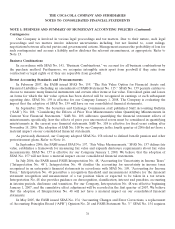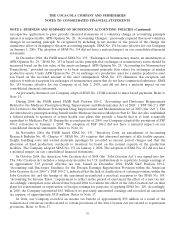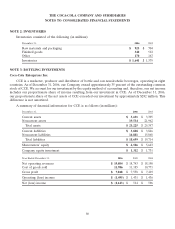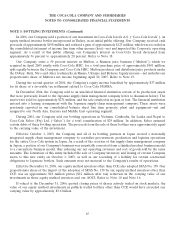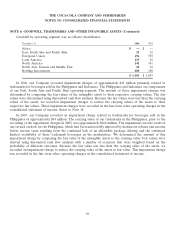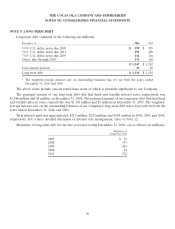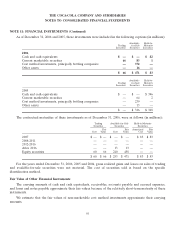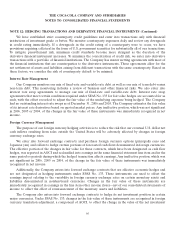Coca Cola 2006 Annual Report Download - page 87
Download and view the complete annual report
Please find page 87 of the 2006 Coca Cola annual report below. You can navigate through the pages in the report by either clicking on the pages listed below, or by using the keyword search tool below to find specific information within the annual report.THE COCA-COLA COMPANY AND SUBSIDIARIES
NOTES TO CONSOLIDATED FINANCIAL STATEMENTS
NOTE 3: BOTTLING INVESTMENTS (Continued)
In 2006, our Company sold a portion of our investment in Coca-Cola Icecek A.S. (‘‘Coca-Cola Icecek’’), an
equity method investee bottler incorporated in Turkey, in an initial public offering. Our Company received cash
proceeds of approximately $198 million and realized a gain of approximately $123 million, which was recorded in
the consolidated statement of income line item other income (loss)—net and impacted the Corporate operating
segment. As a result of this public offering, our Company’s interest in Coca-Cola Icecek decreased from
approximately 36 percent to approximately 20 percent. Refer to Note 18.
Our Company owns a 50 percent interest in Multon, a Russian juice business (‘‘Multon’’), which we
acquired in April 2005 jointly with Coca-Cola HBC, for a total purchase price of approximately $501 million,
split equally between the Company and Coca-Cola HBC. Multon produces and distributes juice products under
the Dobriy, Rich, Nico and other trademarks in Russia, Ukraine and Belarus. Equity income—net includes our
proportionate share of Multon’s net income beginning April 20, 2005. Refer to Note 19.
During the second quarter of 2004, the Company’s equity income benefited by approximately $37 million
for its share of a favorable tax settlement related to Coca-Cola FEMSA.
In December 2004, the Company sold to an unrelated financial institution certain of its production assets
that were previously leased to the Japanese supply chain management company (refer to discussion below). The
assets were sold for approximately $271 million, and the sale resulted in no gain or loss. The financial institution
entered into a leasing arrangement with the Japanese supply chain management company. These assets were
previously reported in our consolidated balance sheet line item property, plant and equipment—net and
assigned to our North Asia, Eurasia and Middle East operating segment.
During 2004, our Company sold our bottling operations in Vietnam, Cambodia, Sri Lanka and Nepal to
Coca-Cola Sabco (Pty) Ltd. (‘‘Sabco’’) for a total consideration of $29 million. In addition, Sabco assumed
certain debts of these bottling operations. The proceeds from the sale of these bottlers were approximately equal
to the carrying value of the investment.
Effective October 1, 2003, the Company and all of its bottling partners in Japan created a nationally
integrated supply chain management company to centralize procurement, production and logistics operations
for the entire Coca-Cola system in Japan. As a result of the creation of this supply chain management company
in Japan, a portion of our Company’s business was essentially converted from a finished product business model
to a concentrate business model, thus reducing our net operating revenues and cost of goods sold by the same
amounts. The formation of this entity included the sale of Company inventory and leasing of certain Company
assets to this new entity on October 1, 2003, as well as our recording of a liability for certain contractual
obligations to Japanese bottlers. Such amounts were not material to the Company’s results of operations.
Effective December 31, 2006, our equity method investees other than CCE also adopted SFAS No. 158. Our
proportionate share of the impact of the adoption of SFAS No. 158 by our equity method investees other than
CCE was an approximate $18 million pretax ($12 million after tax) reduction in the carrying value of our
investments in those equity method investees and our AOCI. Refer to Note 10 and Note 16.
If valued at the December 31, 2006, quoted closing prices of shares actively traded on stock markets, the
value of our equity method investments in publicly traded bottlers other than CCE would have exceeded our
carrying value by approximately $3.6 billion.
85





